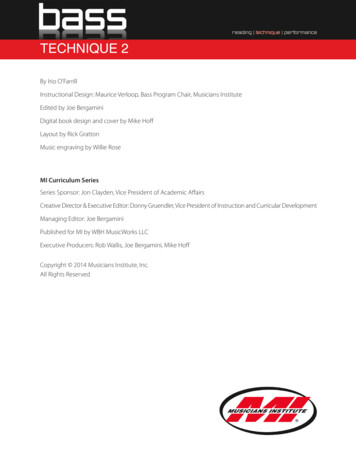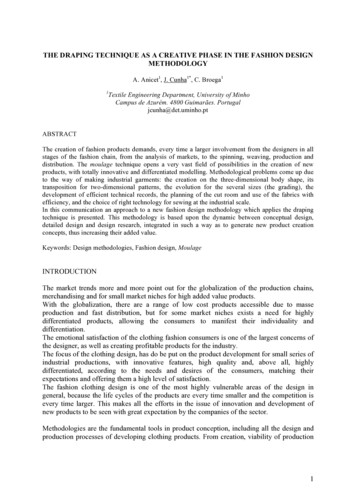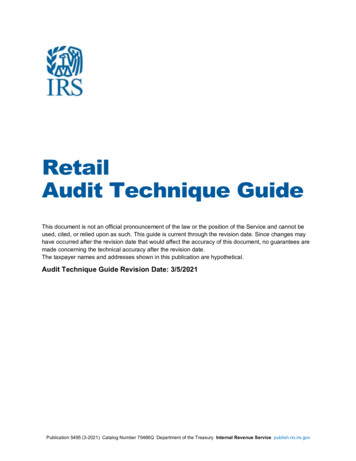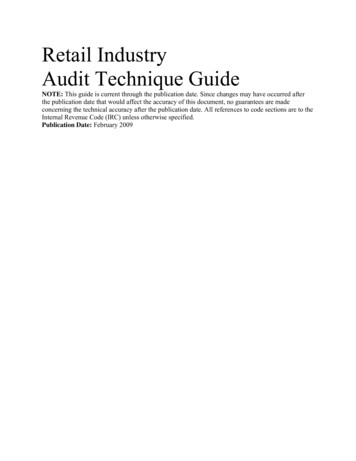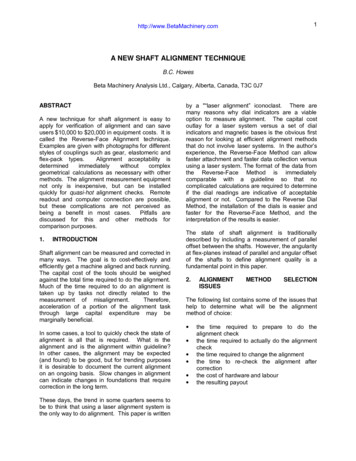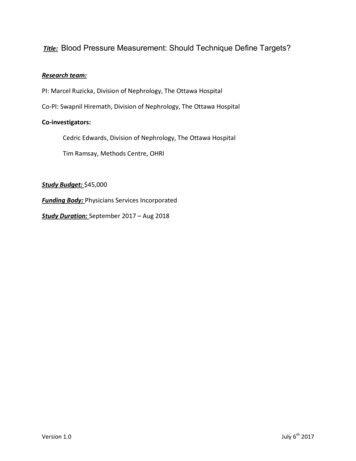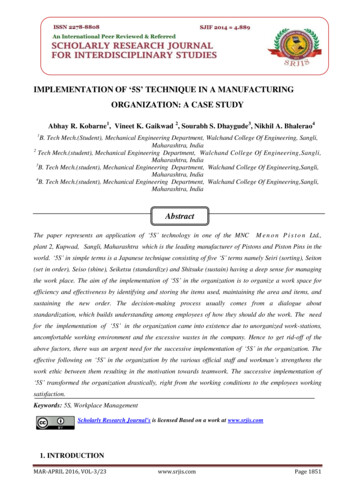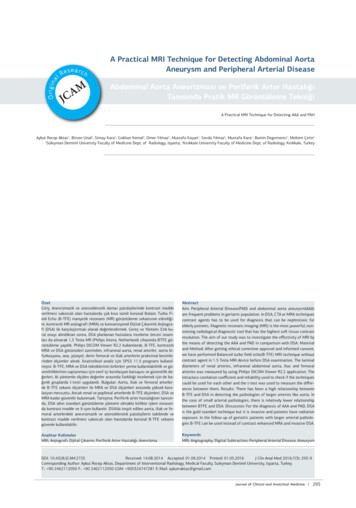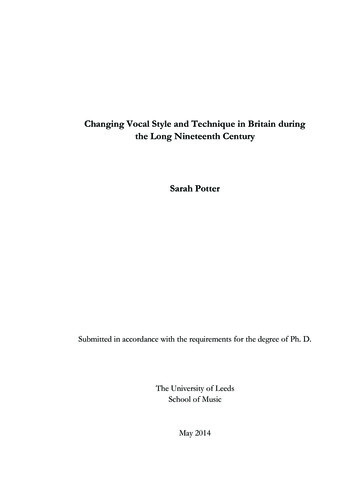
Transcription
Journal of European Public PolicyISSN: (Print) (Online) Journal homepage: https://www.tandfonline.com/loi/rjpp20‘Regime vetting’: a technique to exercise EUmarket powerJohannes JarlebringTo cite this article: Johannes Jarlebring (2021): ‘Regime vetting’: a technique to exercise EUmarket power, Journal of European Public Policy, DOI: 10.1080/13501763.2021.1874042To link to this article: https://doi.org/10.1080/13501763.2021.1874042 2021 The Author(s). Published by InformaUK Limited, trading as Taylor & FrancisGroupView supplementary materialPublished online: 22 Jan 2021.Submit your article to this journalArticle views: 70View related articlesView Crossmark dataFull Terms & Conditions of access and use can be found ation?journalCode rjpp20
JOURNAL OF EUROPEAN PUBLIC 2‘Regime vetting’: a technique to exercise EU marketpowerJohannes JarlebringDepartment of Government, Uppsala Universitet, Uppsala, SwedenABSTRACTThere is a broad consensus that the EU has great sources of power but littleagreement on how and when this power is actively leveraged to shapeglobal market regulation. Scholars have noted a widespread fragmentationand called for studies that cover multiple cases and account for howcontextual factors influence strategic aims. This article responds to these callsby conceptualizing ‘regime vetting’ as a technique used by the EuropeanUnion to reach beyond its borders in various sectors. By coining this term,the article enables exploration of a form of active and de-centred powerprojection that leverages the EU’s main sources of power. The article alsooffers a typology of four different types of regime vetting and propositionson how internal and external contextual factors systematically shape thestrategic uses of regime vetting, thereby contributing to the theoreticaldiscussion on how ‘context matters’ in shaping EU external action.KEYWORDS Digital markets; European Union; regime vetting; regulation; sustainability; tradeIntroductionFor decades, leading figures in the European Union (EU) have emphasized itsability to project external power by leveraging its large internal market, andits aspiration to help lead the shaping of global market regulation (Damro,2012). Many scholars have scrutinized the underpinnings of these grandambitions by examining the sources, expressions and impacts of EU externalpower in the regulatory field (Bach & Newman, 2007; Bradford, 2020; Damro,2012, 2015; Drezner, 2008; Lavenex, 2014; Müller et al., 2014; Vogel, 2012;Young, 2015a; Zeitlin, 2015). There is a broad consensus that the EU hasgreat sources of power – a large internal market, sophisticated regulatorycapacity and stringent market rules – and a growing understanding of thedifferent ways in which the EU interacts with its external eDepartment of Government, Uppsala University,Gamla Torget 6, Uppsala 751 20, SwedenSupplemental data for this article can be accessed https://doi.org/10.1080/13501763.2021.1874042. 2021 The Author(s). Published by Informa UK Limited, trading as Taylor & Francis GroupThis is an Open Access article distributed under the terms of the Creative Commons Attribution License (http://creativecommons.org/licenses/by/4.0/), which permits unrestricted use, distribution, and reproduction in anymedium, provided the original work is properly cited.
2J. JARLEBRINGenvironment. However, the understanding of how and when the EUleverages its internal sources of power to actively influence third countryregimes remains incomplete. Scholars have noted widespread fragmentationand compartmentalization, and called for studies that go beyond single orclosely related cases, and take account of how variations in context help toshape EU-global interactions (Müller et al., 2014; Young, 2015a).This article responds to these calls by conceptualizing a specific techniqueused by the EU in a wide range of sectors to actively project external power inthe regulatory field. Put simply, this technique – which I dub regime vetting –implies that the EU systematically assesses third countries’ regulatory performance in a particular sector and, based on this assessment, either facilitates or restricts their market access in that sector. The main aim of thisarticle is to introduce regime vetting as a new concept and demonstrate itssignificance and utility for research on the EU as a global regulator. I thusdefine regime vetting to show that it is tightly linked to the EU’s mainsources of power and distinct with regard to other techniques in the EU’spower repertoire. I also identify four distinct types of regime vetting anddemonstrate, based on a host of empirical examples, how these are usedby the EU.Regime vetting is distinct from other means of actively reaching beyondborders, such as centrally managed ‘foreign policy’, soft ‘functionalist extension’ (Lavenex, 2014) or the automatic ‘Brussels effect’ (Bradford, 2020), as itrelies on de-centred monitoring systems, generates significant economicincentives based on market access and serves to actively co-opt thirdcountry regulators. These features make the technique particularly relevantin markets where controls at the border are impossible or impractical, requiring the EU to reach beyond its borders to drive specific changes in thirdcountry regulatory regimes. The various examples in this article demonstratehow the EU projects significant external power through regime vetting whenit comes to ensuring the sustainable use of natural resources, such as fish andforests, and to encourage responsible behaviours in digital and financialmarkets. When effectively applied, regime vetting eases the tensionbetween free trade and stringent EU policies in these areas by ensuringthat trading partners ‘generally satisfy or conform to’ its regulatory policies(Damro, 2012, p. 690).This conceptualization of regime vetting allows for a nuanced understanding of a power repertoire that has been only partially described and explainedby previous research. A main contribution is the introduction and examination of the term ‘coercive regime vetting’ to capture how the EU leveragesmarket access as a stick in relation to third countries, as it screens externaljurisdictions in a particular sector and restricts the market access of thosethat are considered to be particularly poor performers. The conceptualizationof this type in turn helps to bring out the specific meaning of other practices,
JOURNAL OF EUROPEAN PUBLIC POLICY3some of which have been extensively studied by previous research. Mostnotably, the term ‘assertive regime vetting’ is introduced to capture howthe EU facilitates market access for jurisdictions seen as equivalent to theEU’s in certain key regards (Newman & Posner, 2015). In still other cases,regime vetting is ‘supportive’, as the EU actively helps third countries todevelop regulatory performance, or ‘validating’, as it aims simply to facilitatetrade with major partners with little intention of driving regulatory change. Bybringing together these various practices, which were not previously perceived to be part of a coherent technique, under the broad category ofregime vetting and sorting them into distinct types, this article contributesto a better understanding of how the EU leverages its internal sources ofpower to project power externally in the regulatory field.As an additional contribution, the article builds on the proposed typologyto develop theoretical propositions regarding the contexts in which the EUcan be expected to apply different types of regime vetting. While previousresearch has highlighted the importance of external contexts in shapingpolicy strategies in the regulatory field (Newman & Posner, 2015; Simmons,2001), I argue that when it comes to active power projection throughregime vetting, which is generally based on formalized processes enshrinedin EU law, the internal context also contributes to shaping policy strategies.In line with this, it is proposed that the most powerful types of regimevetting become available to EU executive powers only in an internalcontext where there are significant fears about negative externalities fromabroad. This theoretical proposition contributes to the debate on the roleplayed by context in shaping external regulatory action (Müller et al., 2014;Young, 2015a), and more specifically to the question of when the EUleverages its internal sources of power to actively influence third countryjurisdictions.While based on extensive empirical material, the article stops short ofoffering a complete mapping of the EU’s use of regime vetting, and doesnot engage in testing causal mechanisms or effects. Future research canuse and test the conceptual and theoretical contributions offered in thisarticle to establish a more definitive picture of how and when the EUleverages its internal sources of power externally. Besides its obvious importance for understanding the EU’s global role, this research agenda willprepare the ground for studies on the EU’s external impact in the regulatorysphere, an impact which is considered ‘a crucial component of why [the EU]matters in international relations’ (Young, 2015a, p. 1235). The practical relevance of such studies is likely to increase still further in the coming yearsas digitalization and shortages of natural resources make global marketseven more interconnected and interdependent, while the gaps in the regulatory ambitions of the regulatory great powers, such as the EU, the US andChina, are likely to persist. As is discussed in the concluding section, EU
4J. JARLEBRINGleaders are considering applying regime vetting in broad and politically contentious areas, such as mitigating climate change and regulation of the use ofartificial intelligence (AI), which makes an examination of the external effectsof the technique an urgent task for future research.The article is structured as follows. Having briefly described previousresearch on the EU’s repertoire of external powers in the regulatory field,regime vetting is defined and conceptualized. A typology is then developedand propositions regarding the causal relationships between context andtype are proposed. The article concludes with a discussion on the broader relevance of the technique. An online appendix provides a more detaileddescription of how the definition of regime vetting applies in empiricalexamples.THE EU’s repertoire of external powers in the regulatory fieldThere is a broad scholarly consensus that the EU can be considered a regulatory ‘great power’, based on the fact that it has significant sources of powerthat can be projected externally. While different scholars describe thesources of power in slightly different ways, three sources stand out (Young,2015a). The most fundamental is the EU’s large domestic market, or the ‘relative size and diversity of [the] internal market’ (Drezner, 2008, p. 32). A secondsource of power is regulatory capacity, which has been defined as ‘a jurisdiction’s ability to formulate, monitor and enforce a set of market rules’ (Bach &Newman, 2007, p. 831). Finally, the projection of external regulatory power isrelevant and effective only if the EU also has stringent internal market rules(Young, 2015a); that is, if there is a sufficient level of positive integration inthe field.However, scholars disagree on how and when the EU actively leveragesthese sources of power externally. Some examine the centrally coordinated and often coercive means used by classic foreign policy and payparticular attention to trade agreements, based on the starting pointthat the EU’s greatest coercive power lies in requiring parties to tradeagreements to sign up to certain regulatory regimes as a condition oftrade liberalization. A main finding is that while the EU often engagesin such issue linkages to support multilateral regimes, it does not generally use trade agreements to export its domestic regimes and in any casedoes not systematically enforce the conditions (see e.g., Young, 2015a,2015b).1 Other scholars highlight the de-centred power projection thattakes place through ‘functionalist extension’ (Lavenex, 2014, p. 888),underpinned by ‘automatic’ market mechanisms that are often supportedby informal networks of regulators (Young, 2015a, p. 1240). Product standards, in particular, have been seen to have a major automatic externalimpact through ‘the Brussels effect’ or ‘trading-up’, where firms apply
JOURNAL OF EUROPEAN PUBLIC POLICY5EU standards externally even when they are not formally obliged to do so(Bradford, 2020; Vogel, 2012).My contribution to this debate suggests that there is a significant andpoorly understood area between powerful and centrally coordinatedforeign policy and a de-centred functionalist extension of EU policy.Regime vetting is ‘de-centred‘ in the sense that power projection does notrely on broad, cross-sectoral issue linkages, and that sectoral regulators (generally a non-horizontal General Directorate of the European Commission, supported by a network of national regulatory agencies) play a major role inengagements with third countries. At the same time, it is formal and sometimes quite assertive or even coercive, as the EU actively leverages marketaccess to convince third countries to change their domestic regimes, whichmakes it a poor fit with soft and informal ‘functionalist extension’.2Previous attempts to describe the empirical practices denoted by regimevetting have highlighted the EU’s use of specific legal tools such as ‘equivalency’ clauses that condition market access on demonstration of equivalentrules in home markets (Farrell & Newman, 2019, p. 34; Moloney, 2016,p. 467; Newman & Bach, 2014, p. 439; Newman & Posner, 2015, p. 1326;Quaglia, 2015). Others have employed the term ‘territorial extension’ to highlight that these practices often build on internal EU legislation but do notfulfil the criteria for ‘extra-territo
UK Limited, trading as Taylor & Francis Group View supplementary material Published online: 22 Jan 2021. Submit your article to this journal Article views: 70 View related articles View Crossmark data ‘Regime vetting’: a technique to exercise EU market power Johannes Jarlebring Department of Government, Uppsala Universitet, Uppsala, Sweden ABSTRACT There is a broad consensus that the
